BT Sport: looking back at 10 years of innovation and technology advances
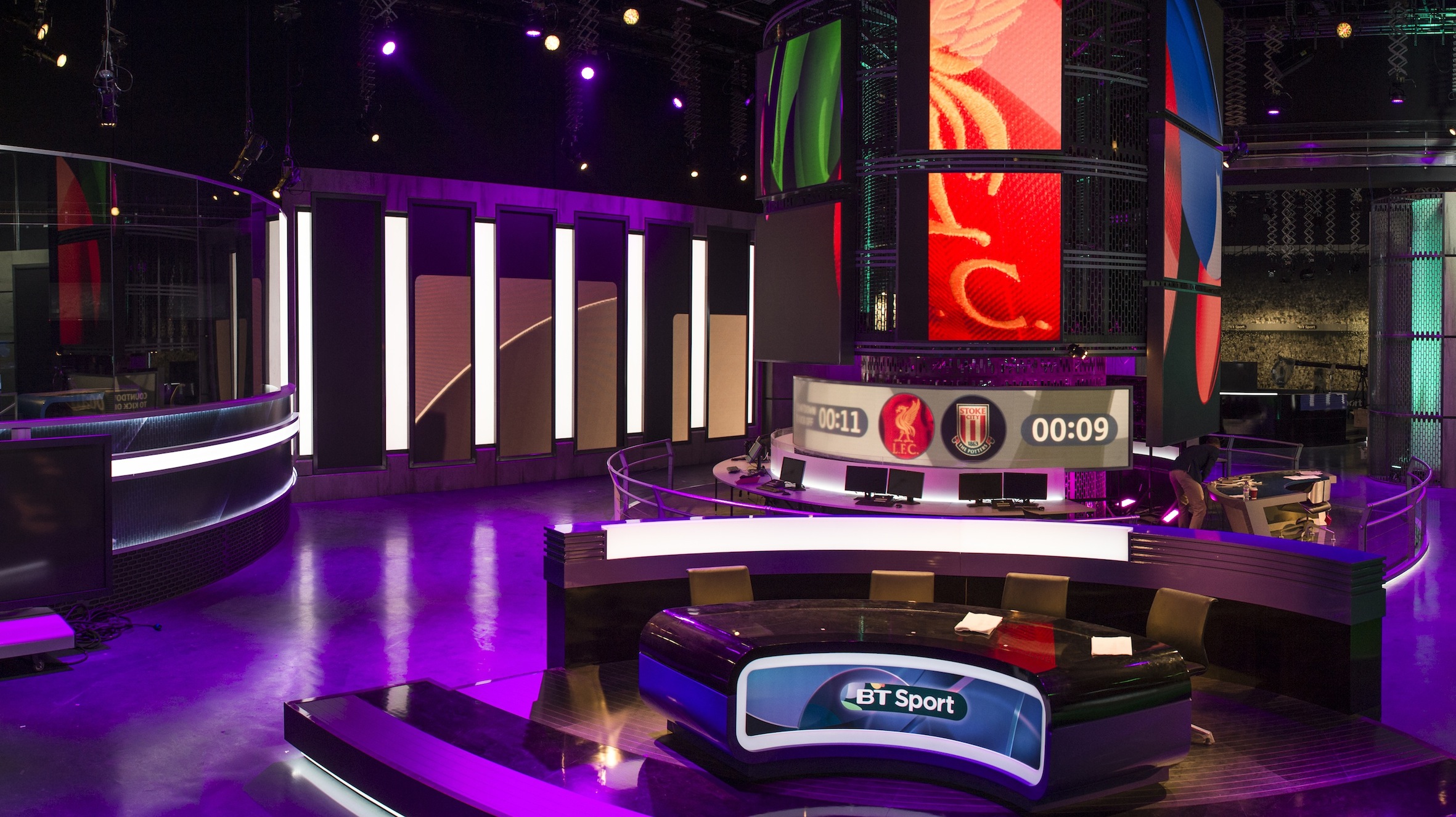
BT Sport’s main studio at the Here East building in the Queen Elizabeth Olympics Park back in 2013
With the BT Sport brand set to disappear in just over a week’s time, SVG Europe reflects on some of the pay-TV broadcaster’s milestones.
On 18 July, the BT Sport brand will disappear from screens in the UK, marking the end of a ten-year period that has been characterised by innovation.
From the launch of the first UHD sports channel in Europe, to debuts for Dolby Atmos, advances in 8K and a pioneering approach to remote production, BT Sport has been synonymous with enhancements in the way sports content is captured, produced and shared with viewers.
Following the joint venture between BT and Warner Bros. Discovery (WBD), the decision was made to adopt the TNT Sports brand – WBD’s sports-focused offering in territories such as South America and the US, where it airs coverage of the NBA. When that was announced back in February, WBD – itself no stranger to innovation – pledged to continue the spirit of what BT Sport has built over the past decade.
But, with many of the BT Sport employees responsible for pushing those boundaries no longer part of what will become TNT Sports, and those who remain moving from BT Sport’s iconic Stratford studios to Warner Bros. Discovery’s facilities in West London, it felt like a timely opportunity to reflect on some of BT Sport’s milestones.
4K, HDR and 8K
Two years after the August 2013 unveiling of BT Sport, the broadcaster launched Europe’s first 4K UHD channel with coverage of the 2015 Community Shield clash between Arsenal and Chelsea. Reporting from the launch, SVG Europe described it as “the biggest game-changer in European sports broadcasting”.
BT Sport worked with long-term partner Timeline Television, which built UHD-1, a bespoke OB truck kitted out with the first deliveries of Sony’s new HDC-4300 2/3 inch UHD 4K camera, the world’s first Fujinon UHD 4K 2/3inch 80:1 box and 22:1 ENG lenses and a Snell Kahuna UHD 4K switcher with Sirius router.
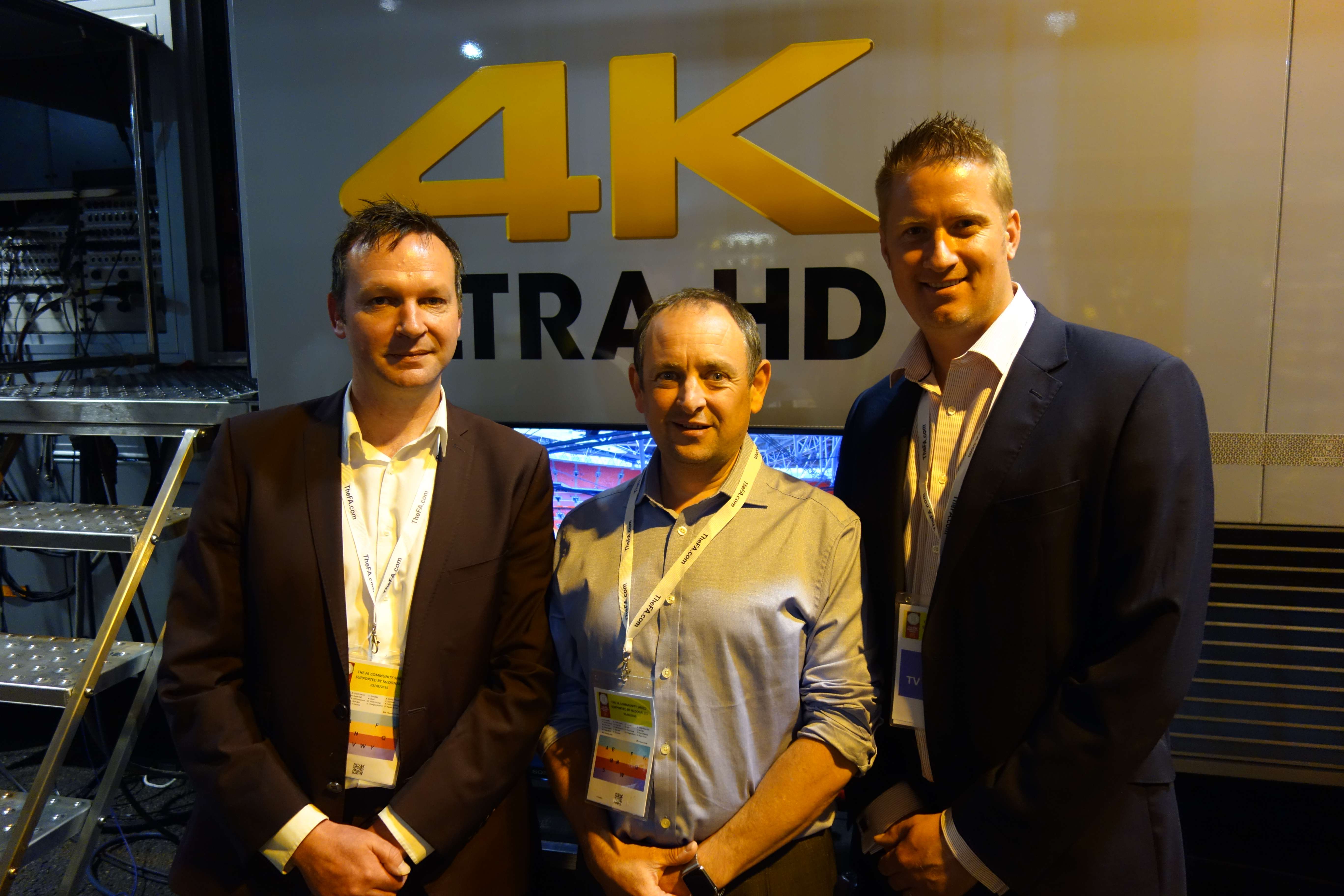
4K UHD leaders (L/R): Jamie Hindhaugh, BT Sport; Dan McDonnell, Timeline TV; and Andy Beale, BT Sport, back in 2015
At the time, BT Sport chief operating officer Jamie Hindhaugh said: “Broadcast innovation is really important: our whole aim for 4K is not about our own self-congratulation, it’s not about getting one over on our competitors. Actually, the whole ethos of BT Sport is how do how do we get the best pictures, the best experience, to our customers.”
Four year later, in August 2019, BT Sport launched a new channel, BT Sport Ultimate, the world’s first service to feature regular programming in High Dynamic Range (HDR), as well as 4K UHD and Dolby Atmos.
One month after the launch of BT Sport Ultimate, the pay-TV broadcaster collaborated with BT’s Media & Broadcast arm to broadcast the world’s first live 8K test broadcast into the IBC exhibition in Amsterdam.
8K kit was in short supply, so a single Ikegami SHK-810 camera (supplemented by a regular UHD 16-camera setup), along with a Fujinon 8K PL-mount lens, Blackmagic Design Atem Constellation 8K vision mixer, encoding and decoding from Appear TV and an 8K scope from Leader plus a custom-built Moov graphics system were used to capture the action at a Premiership Rugby 7s match in Northampton, with the signal carried over BT’s broadcast network to the RAI exhibition and conference centre in Amsterdam.
That was followed in February 2020 with the UK’s first public live 8K sports broadcast, when BT Sport teamed up with Samsung to screen the UEFA Europa League match between Arsenal and Olympiacos to an audience of 50 viewers in the Emirates stadium.
A couple of years later, in March 2022, BT Sport again teamed up with BT Media & Broadcast, plus EMG, Appear, Synamedia and host of other vendors to deliver the UK’s first live 8K broadcast of a top-tier sporting event into the home, airing the Saracens v Bristol Bears Premiership Rugby match into selected homes.
The game was produced entirely remotely and without a significant on-site presence, allowing BT Sport to explore OB and production workflows for future live 8K broadcasts, including testing the ability to run 8K HDR with match coverage, domestic presentation and playout including ad insertion.
Immersive audio
It wasn’t just about the pictures; in 2017, BT Sport’s live coverage of a pair of European ties in February (Manchester United v St Etienne, and Manchester City v AS Monaco) aired in Dolby Atmos, which was a first for the UEFA Champions League and Europa League ties.
It followed on from the January 2016 coverage of Liverpool v Chelsea, which was the world’s first live broadcast of Premier League tie in both Ultra HD and Dolby Atmos, which was the culmination of 18 months’ work with Dolby to get the proprietary three-dimensional surround sound system into BT Sport’s live production chain.
Remote production
The lockdowns and restrictions that resulted from the Covid pandemic forced broadcasters around the world to come up with novel ways to remain on air, BT Sport included.
In April 2020, BT Sport moved its entire production operation out of its studios at the Queen Elizabeth Olympic Park, East London, and in just three weeks turned it into a decentralised remote operation. That channel output included seven topical programmes produced live or nearly live with all on-screen participants working alone, based out of their own homes, connected to the production teams by broadband or over EE’s 4G mobile network.
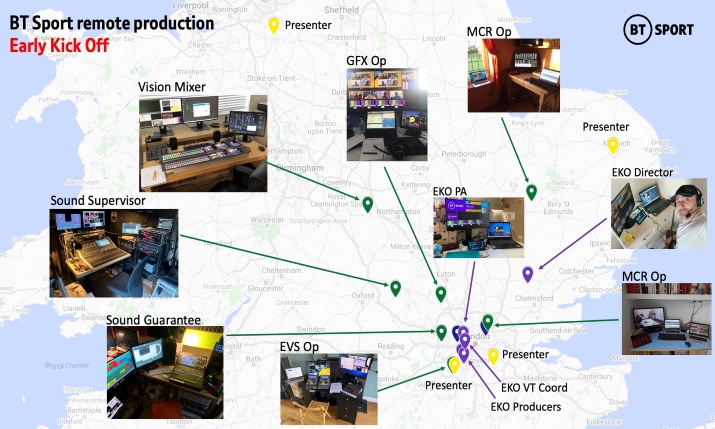
BT Sport’s Live: Early Kick-Off moved to a truly remote, distributed team at the start of lockdown
That led BT Sport in June 2020 to announce that it would “fast-track” its remote production plans, utilising and developing a new remote operating centre in High Wycombe, in partnership with Telegenic (now EMG) for its Premier League coverage.
A month later, the FA Cup Final between Arsenal and Chelsea was produced remotely by BT Sport from High Wycombe with presentation live from Wembley Stadium, plus a remote gallery from the BT Sport studio, broadcasting the game in 4K UHD with HDR and Dolby Atmos.
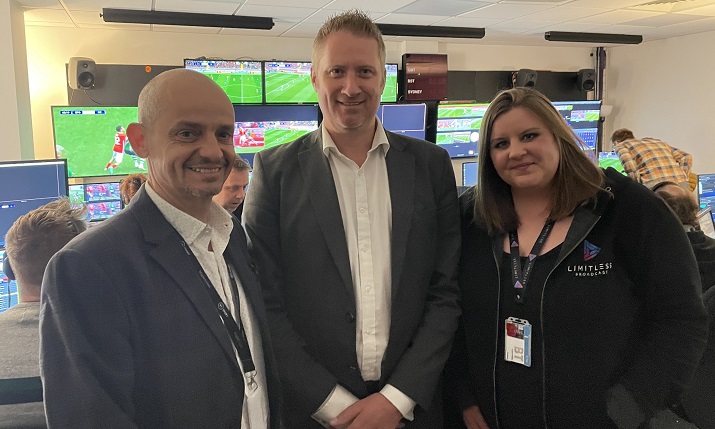
UEFA Youth League: UEFA’s Eric Orengo, BT Sport’s Andy Beale, Limitless Broadcast’s Claire Wilkie
In March 2022, BT Sport embarked on the next stage of its decentralised remote production evolution, producing its Fight Week Live: UFC London preview show in the cloud.
And more recently, in April this year, a 12-camera production of the UEFA Youth League semi-final tie between Portugal’s Sporting CP and Dutch club AZ Alkmaar in Switzerland developed the concept of cloud-based remote production even further.
5G
Over the years, BT Sport has been able to partner with BT Media and Broadcast on many of its trials, and following the 2015 acquisition of EE, the broadcaster was able to team up with the mobile operator and use its network for its trials, particularly relating to contribution.
That partnership was in evidence in 2018, when BT Sport and EE successfully carried out the world’s first live broadcast over 5G using remote production, delivering a two-way transmission from Wembley Stadium to London’s ExCeL exhibition centre.
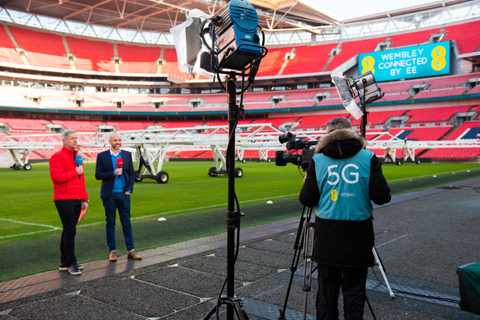
BT Sport presenter, Matt Smith, and Matt Stagg, director of mobile strategy, at Wembley Stadium taking part in the first ever remotely produced live broadcast over 5G in November 2018
At the time, Andy Beale, chief engineer at BT Sport, said: “[With 5G] you can get shots you haven’t ever done before, from the changing rooms to walking in the tunnel; it really does unlock it…it’s not just about doing things more efficiently, it’s doing things you haven’t even thought of doing before.”
Looking even further to the future, in March 2022 EE and BT Sport unveiled new ways to watch and experience sports and the performing arts using 5G and extended reality (XR) technology, developed through an EE and BT Sport-led project, 5G Edge-XR.
The project demonstrated how the potential of EE’s 5G network, paired with cloud graphics processing units, can enable consumers to view events in a range immersive ways.
Social, mobile and immersive experiences
In late 2020 during the Covid-19 pandemic, when contact with others was discouraged or prohibited, BT Sport and EE teamed up to launch Matchday Experience on the BT Sport App, offering fans what was described as the most immersive sports viewing experience in the UK to select BT Sport customers using iPhones or iPads.
One feature, ‘Watch Together’, used a split-screen interface to allow users to watch any BT Sport live broadcast along with three other subscribers. It was made available to all BT Sport customers, including Android users, in February 2021.
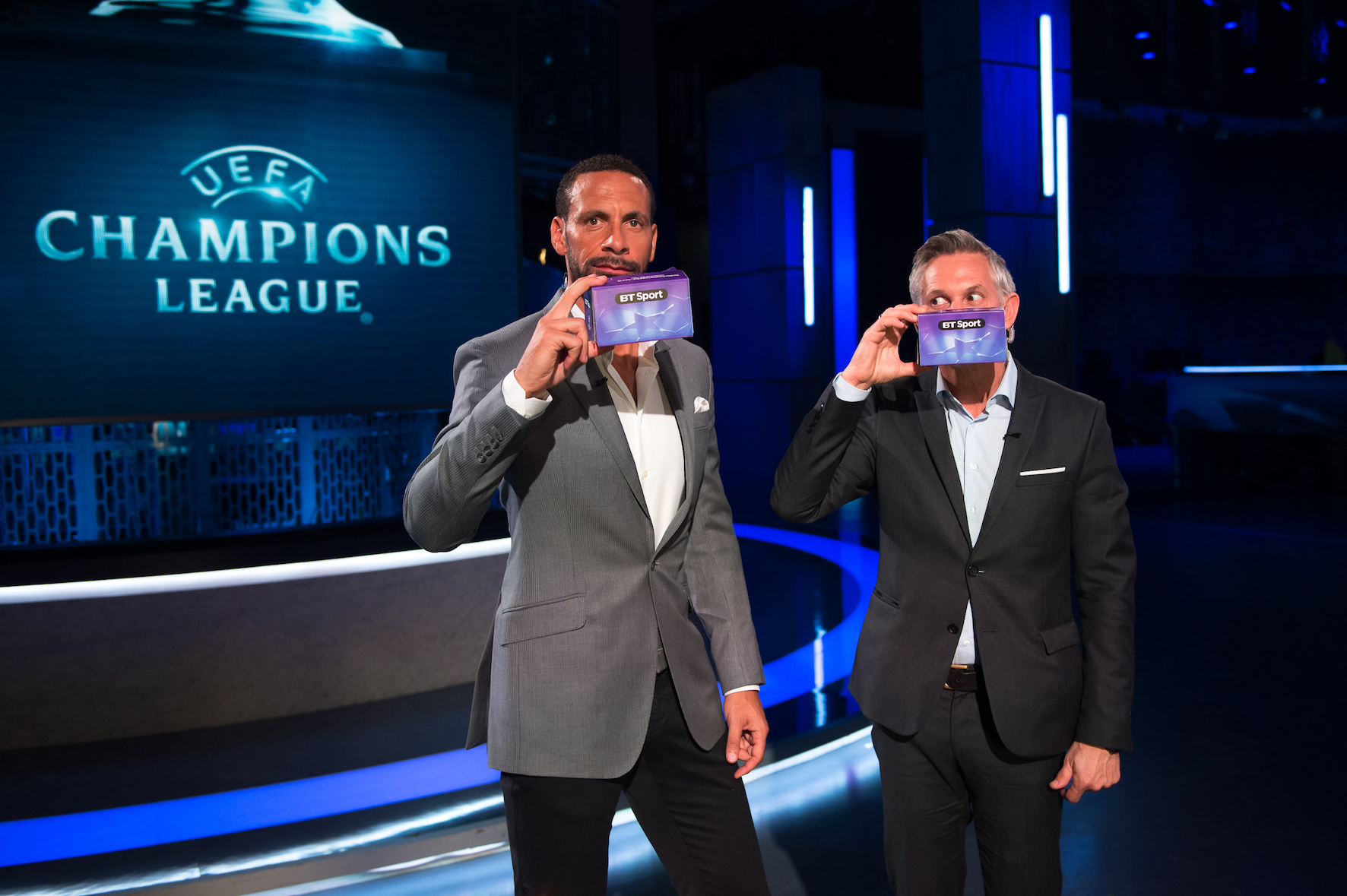
A few months after the group of sports channels launched, BT Sport announced its acquisition of UEFA Champions League rights. It then took the opportunity to air its first UCL Final – the 2016 tie between Real Madrid and Atletico Madrid – with a wider audience on YouTube, which was the first time the Champions League and UEFA Europa League finals had been made available on the site.
The Champions League Final – and YouTube – again provided the stage and setting for some more high-profile experimentation, with BT Sport showing multiple 360-degree streams of the UCL final from Cardiff in June 2017, with 4K feeds captured via 12 Nokia Ozo cameras and made available on YouTube and the BT Sport app.
A year later, in 2018, BT Sport offered a free live 4K stream of the Champions League final on YouTube for the first time as Real Madrid defeated Liverpool.
In another UK first, 360-degree and virtual reality functionality was added to the BT Sport’s ‘Enhanced player’, a digital streaming service launched in 2015 that featured interactive timeline and multicam replays.

